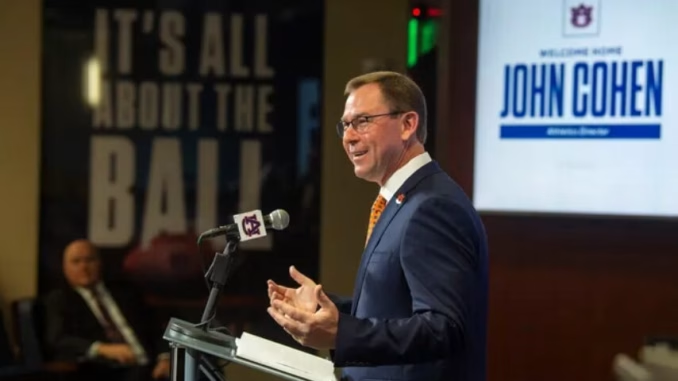
Since the summer of 2021, no three words have dominated college athletics more than Name, Image and Likeness.
NIL has been talking point No. 1 across college sports in the almost four years it has been around, and the topic remains unpredictable and ever-changing. Now, with the impending House settlement that could soon bring revenue sharing to college sports, there’s never been more financial uncertainty for college athletic departments across the country.
That’s no different at Auburn, an athletic program that has been competitive in NIL, but still faces the financial uncertainties brought on by the expected major changes coming to how revenue is distributed.
Athletic director John Cohen talked about Auburn’s spot in the current NIL landscape in an interview with AL.com, speaking candidly about the uncertainty with NIL that lies ahead.
“If you asked me, ‘Are we competitive in this area through our collective or exactly what we’re going to do if the settlement happens on April 7, and moving forward to July 1?’ I don’t know,” Cohen said. “I can guess, and I feel like through knowing people all over the country, you can get some information, but, yeah, I think you’ve really hit on something here.”
Cohen believes Auburn is “doing a good job” in NIL, but pointed out how hard the assessment is to make given the lack of transparency in the NIL world.
“We don’t know what anybody else is doing, because there’s no transparency of anything,” Cohen said. “Do I think we’re doing a good job this area? Yes, I do, but I just don’t have a real sense. And when I hear numbers that are thrown out in the media, no criticism of the media, but I don’t believe that either.”
Cohen also called the current NIL landscape unsustainable, due to the lack “standardization” across the board.
Since student athletes aren’t being paid directly by the schools or under contract to their schools in the current model, there are no limits on how much programs can spend on players through their collectives and various NIL deals, nor are there contractual obligations through the school for athletes to abide by.
That creates what many consider to be an uneven playing field, even among Power Four programs, and what has become annual free agency in the transfer portal, a system that puts schools with less NIL support at a significant disadvantage.
“The current model is not sustainable,” Cohen said. You hear that every single day, and it’s not sustainable for a variety of reasons, probably the most of which is anytime you have some type of compensation, there are realities that come with that, and it doesn’t matter what line of work we’re talking about. And they’re usually contractual when you talk about the dollars that that we’re talking about.
“There has to be some form of standardization,” Cohen continued. “The good news is at least at the professional level, and I’m not saying that this is professional, but at the professional level there are very strict guidelines. There is a standard, there is a way in which everyone goes about their business in terms of the compensation model and in terms of contractual obligations, and I look forward to a day when that becomes our reality.”
That could be coming as soon as later this year with the impending House settlement that would officially bring revenue sharing into college sports.
Leave a Reply